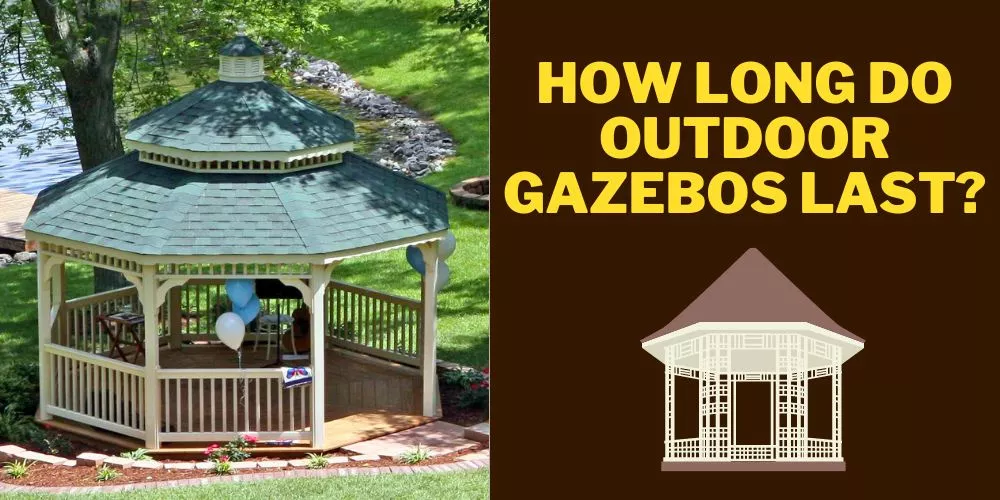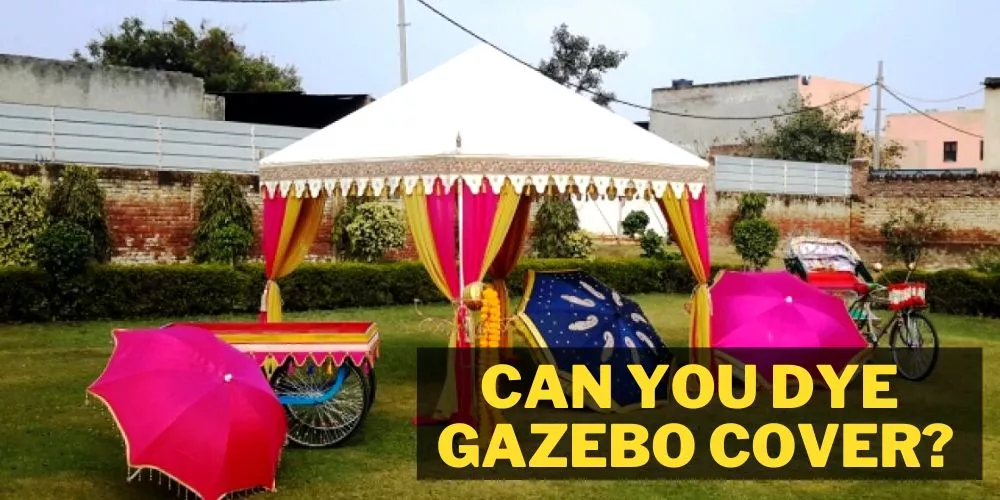Are you thinking about installing a gazebo over a fire pit? This combo can turn your backyard into a cozy retreat, ideal for relaxation and entertainment. But, it’s not without its challenges, especially when it comes to ensuring safety and complying with local regulations.
In this guide, I will equip you with essential know-how gathered over 30 years in the field, helping you answer the question “can you put a gazebo over a fire pit?”.
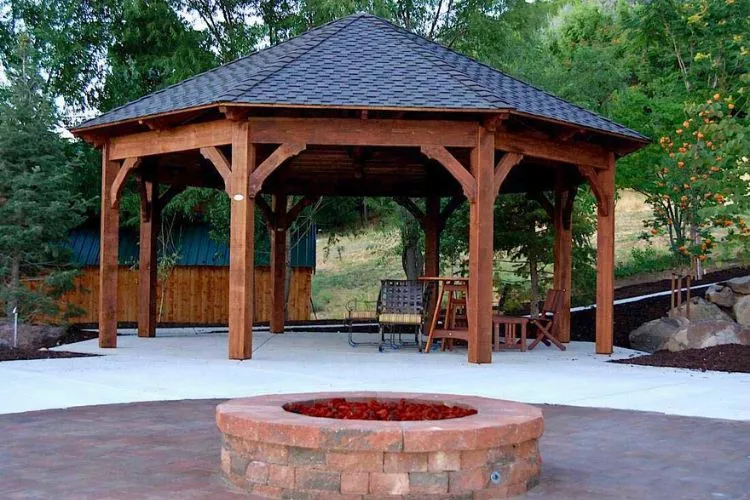
Can You Put a Gazebo Over a Fire Pit?
While typical open fire pits are unsafe to use under a gazebo due to the fire risks and smoke damage, gas fire pits could be used safely. This is because gas fire pits produce less smoke and are easier to control. However, it’s still essential to have proper ventilation and a high enough gazebo ceiling to prevent heat buildup.
Fire-resistant materials should also be used for the gazebo construction. Always follow the manufacturer’s guidelines and local fire safety regulations when installing and operating a fire pit within a gazebo.
Key factors to consider
From selecting the appropriate size and layout to choosing a fire pit that aligns with your expectations and the local weather conditions, each element plays a pivotal role. Here, I’ll discuss these key factors, aiding you in creating a space that is both aesthetically pleasing and functionally sound.
Size and layout of the gazebo
The foundation of a good project lies in its planning phase. The size and layout of your gazebo are primary considerations in this journey. The layout should harmonize with your yard’s existing structures, offering a seamless blend of style and functionality. Meanwhile, the size should accommodate not only the fire pit but also seating areas, ensuring enough space for movement and relaxation. Remember, it’s all about creating a space that epitomizes comfort and safety, where you can enjoy warm gatherings with loved ones.
Fire pit type and size
Equally significant is choosing the right type and size of the fire pit. The market offers an array of options, from traditional wood-burning fire pits that bring a rustic charm to modern gas fire pits that offer convenience and cleanliness. When deciding on the size, take into account the dimensions of your gazebo, ensuring it complements the structure without overpowering it. This balance will facilitate a cozy, inviting atmosphere, setting the stage for memorable evenings.
Local climate and weather conditions
Lastly, don’t overlook the impact of local climate and weather conditions on your project. If your region is prone to heavy rains or snow, considering roofing options and drainage systems for your gazebo becomes vital. Furthermore, areas with frequent windy conditions necessitate the installation of protective barriers or screens to keep the fire contained and prevent embers from flying out. Adapting your gazebo and fire pit setup to suit the local climate ensures longevity and enhances safety, promising countless seasons of enjoyment.
Professional consultation and plans
Embarking on this journey might leave you with a plethora of questions and decisions to make. This is where the expertise of a professional consultant comes into play. Leveraging their experience can help you carve out plans that are not only visually appealing but also adhere to safety standards.
They can assist in material selection, suggest the best layouts considering the natural elements in your locality, and offer guidance on meeting local regulations and permits. Investing in professional consultation ensures that every detail, even those you hadn’t considered, is looked into with a scrutinizing eye, paving the path for a smooth and successful project execution.
DIY vs. hiring a contractor
Now, the pressing question – to embark on a DIY project or to entrust the task to a seasoned contractor? The DIY route might be appealing for its personal touch and potential cost-saving aspect. However, it comes with its set of challenges, including the need for a considerable skill set and time investment.
On the other hand, hiring a contractor alleviates the stress associated with managing such a project. A contractor brings to the table expertise, resources, and experience in handling similar projects, thus ensuring a higher level of craftsmanship and compliance with local regulations.
Your choice between DIY and hiring a contractor would depend largely on your comfort level with handling construction projects, the complexity of your desired setup, and your budget constraints. Regardless of the path you choose, ensuring meticulous planning and adherence to safety norms should be the priority.
Safety Considerations
Before embarking on the exciting journey of installing a gazebo over a fire pit, it’s imperative to prioritize safety. This section outlines critical precautions and guidelines that will enable you to create a beautiful yet safe outdoor haven. Let’s delve into the necessary measures to ensure your project is both stunning and secure.
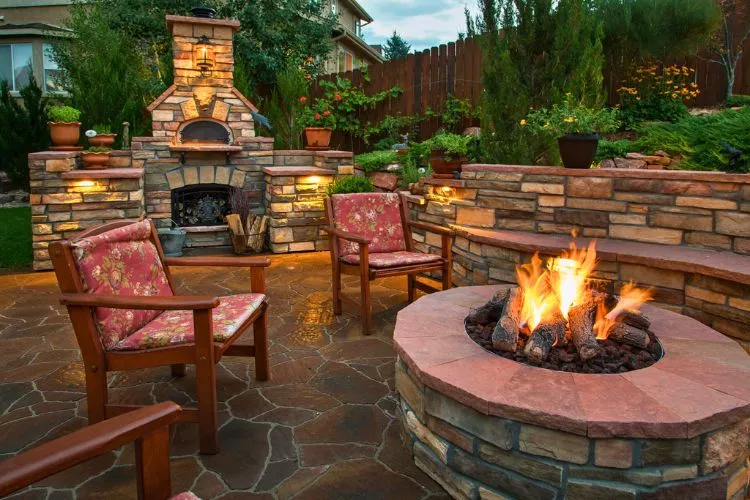
Importance of safety when combining fire and structures
Combining a gazebo with a fire pit has the potential to create a backyard paradise, but it also introduces some inherent risks. The proximity of flammable structures to open flames necessitates a keen focus on safety to prevent accidents and damage. Over the past 30 years, I’ve witnessed firsthand the dire consequences of overlooking safety precautions.
This knowledge underscores the imperative of planning and implementing safety measures meticulously. In this segment, we will explore the critical steps and considerations that should guide your project to ensure a safe and enjoyable outcome.
Ventilation
Good ventilation is more than just a comfort consideration—it’s a crucial safety feature when you have a gazebo over a fire pit. Having overseen countless installations over the past three decades, I can’t stress enough how important it is to plan for adequate ventilation right from the outset.
First, it’s vital to prevent the buildup of harmful gases. Carbon monoxide, a byproduct of burning materials, is odorless and colorless, making it a silent but serious hazard. Adequate ventilation ensures that any gases produced are quickly dispersed, safeguarding the health of those enjoying the fire pit.
Secondly, well-planned ventilation helps in reducing the smoke that emanates from the fire pit. Smoke can be a nuisance, causing both discomfort and respiratory issues. Strategic ventilation design can minimize this, channeling smoke away from the seating area and creating a more pleasant environment.
Moreover, ventilation also plays a pivotal role in maintaining the integrity of the gazebo structure. It prevents the buildup of heat, protecting wooden structures and other flammable materials from getting too hot and potentially catching fire.
When planning the ventilation, consider the following factors:
- Positioning of the Fire Pit: Place the fire pit in an area where the wind can naturally disperse smoke and gases.
- Gazebo Design: Opt for a gazebo design that allows for easy airflow, possibly with adjustable vents or open sides.
- Chimney Installations: If your setup is more enclosed, a chimney can be installed to channel smoke upwards and away from the gazebo’s occupants.
Fire safety guidelines
When setting up a gazebo over a fire pit, adhering to established fire safety guidelines is non-negotiable. These guidelines serve as a roadmap, helping to prevent mishaps while enjoying your fire pit safely. In this part, we’ll outline specific recommendations and guidelines that are vital in preventing fire accidents and ensuring the safety of everyone around.

Distance between fire pit and gazebo
Maintaining a safe distance between your fire pit and the gazebo structure is an elemental safety consideration. Generally, a minimum safe distance of 10 to 20 feet (3 to 6 meters) is recommended to prevent any potential fire hazards or heat damage to the gazebo’s materials. This distance might vary depending on the specific characteristics of your fire pit and gazebo, but it’s a reliable standard that I’ve found effective in my 30 years of experience.
Furthermore, it is advisable to consult with a local expert or regulatory body to ensure compliance with any regional specifications. Adequate spacing not only guarantees safety but also allows for comfortable seating and movement around the fire pit.
Fire-resistant materials
In my many years of experience crafting outdoor spaces, I’ve learned that choosing the right materials can quite literally be the difference between a tranquil retreat and a potential fire hazard. Incorporating fire-resistant materials in your gazebo construction isn’t just a recommended safety measure; it’s an essential component that can significantly mitigate the risk of fire incidents.
Fire-resistant materials are specially designed to withstand high temperatures, hindering the spread of flames in the unfortunate event of a fire. Here, we’ll discuss several materials that can be considered, each offering a blend of safety and aesthetic appeal:
- Metal: Metals like aluminum and steel are non-combustible and can endure high temperatures, making them excellent choices for gazebos. Their durability and resistance to fire make them a popular choice for structures near fire pits.
- Fire-Retardant Treated Wood: While traditional wood is highly flammable, wood that has been treated with fire-retardant chemicals offers a safer alternative. This type of wood slows down the spread of flames, buying you crucial time in case of a fire.
- Concrete: For solid and fire-resistant flooring, concrete stands as a robust option. It’s not only resistant to fire but also offers a sleek, modern look that can enhance the beauty of your outdoor space.
- Glass: When considering enclosure options, tempered glass is a suitable choice. It withstands higher temperatures compared to regular glass and, if broken, shatters into small pieces, reducing the risk of injury.
- Fire-Resistant Fabrics: For any upholstery or curtains in the gazebo, opt for fabrics treated with fire-retardant chemicals. These materials resist catching fire easily and are a safer choice near a fire pit.
When planning your gazebo, it’s vital to incorporate these materials in various aspects of the construction, including the flooring, roofing, and any side enclosures. Combining these with other safety measures, like proper ventilation and distance from the fire pit, creates a secure and serene environment for you to enjoy.
Fire extinguisher placement
Having spent decades honing my craft and learning the fine nuances of creating safe and enjoyable outdoor spaces, I can affirm that the placement of fire extinguishers isn’t just a prudent safety measure—it’s a critical one that can potentially save lives and property. Let’s dive deep into this often overlooked yet vital facet of setting up a gazebo over a fire pit.
Ensuring easy access to a functioning fire extinguisher can make a significant difference in the event of an emergency. Here are several key factors to consider when deciding on the placement of fire extinguishers in your gazebo setup:
- Accessibility: The fire extinguisher should be placed in a location where it can be quickly and easily accessed. Avoid tucking it away in a corner or a hard-to-reach place, as time is of the essence during a fire emergency.
- Visibility: Install the fire extinguisher in a highly visible spot so that in the event of a fire, anyone can spot and reach it without wasting precious seconds searching for it. Signage indicating its location can also be beneficial.
- Near Potential Fire Sources: While maintaining a safe distance, the fire extinguisher should be installed closer to potential sources of fire, like the fire pit or a barbecue grill, to ensure swift response in case of a fire outbreak.
- Protection from Elements: Given that gazebos are outdoor structures, it’s vital to protect the fire extinguisher from weather elements to ensure its functionality. Consider a protective cabinet or cover as a protective measure.
- Instructional Information: Near the fire extinguisher, consider placing a small instructional board or sticker with guidelines on how to use it correctly, ensuring that even individuals unfamiliar with its operation can use it in an emergency.
- Regular Inspections: Make a schedule to inspect the fire extinguisher periodically to ensure it’s in working condition. This practice ensures that it’s ready to use whenever necessary.
Investing in a quality fire extinguisher and ensuring its optimal placement isn’t just about following regulations; it’s about fostering a space where safety and enjoyment go hand in hand.
Local regulations and permits
Embarking on the exciting journey of installing a gazebo over a fire pit involves more than just selecting the perfect spot and materials; it also means navigating through the network of local regulations and permits that govern such constructions. Ensuring compliance with these not only safeguards the legality of your project but also guarantees the safety and harmony of your community. Let’s delve deeper into this essential aspect of the project:
- Understanding Local Codes: Before you begin, familiarize yourself with the local building codes applicable in your area. These rules, which are crafted with safety and environmental considerations in mind, often detail the specifications for structures like gazebos, especially when incorporating fire elements.
- Permit Acquisition: Securing the necessary permits is a crucial step. Though it might seem like a cumbersome process, obtaining the permits helps you align with the local regulations, averting potential legal issues down the line. Moreover, these permits often outline stipulations regarding material selection, safety features, and the necessary distances to observe.
- Consult with Local Authorities: To garner a comprehensive understanding of the requirements, engage with local authorities or planning departments. Their guidance can shed light on the nuances of the regulations, and they might even suggest experts who specialize in these types of projects.
- Neighborhood Restrictions: Should your residence be part of a homeowners’ association, check for any additional guidelines or restrictions in place to maintain the community’s aesthetic and safety standards. Abiding by these rules fosters harmony and a cohesive appearance within your neighborhood.
- Safety Inspections: Once your project reaches completion, be prepared for safety inspections, which are a standard procedure to ensure adherence to local codes. These inspections act as a preventative measure, identifying potential issues before they escalate.
- Insurance Considerations: It is wise to revisit your homeowner’s insurance policy to check for clauses pertaining to structures incorporating fire elements. Adhering to these conditions is vital to prevent complications with future claims, if any.
Taking the time to research and comply with local regulations and permits ensures that your gazebo over a fire pit project is both a safe and legally sound addition to your home. Remember, diligent preparation paves the way for a smooth, hassle-free project that stands the test of time.
Gazebo Types & Designs for Combining With a Fire Pit
In the pursuit of creating a backyard sanctuary, choosing the right type and design of gazebo holds paramount importance. The merger of a fire pit and gazebo can transform your outdoor space into a haven of comfort and style, but it demands a thoughtful selection from various available options. In this segment, we explore the different gazebo types and designs that blend harmoniously with fire pits, setting the stage for a picturesque and functional retreat right in your backyard.
Different types of gazebos
When it comes to enhancing your outdoor living space, selecting the right type of gazebo is a crucial decision. The different styles and structures offer a unique charm and functionality tailored to your preferences and the specificities of your space. Let’s delve into the various types of gazebos that can elegantly couple with a fire pit, adding a warm and inviting atmosphere to your backyard.
Open-air gazebos
Open-air gazebos are the epitome of merging nature with comfort. These structures, typically without walls, allow a free flow of air, offering an unrestricted view of the surrounding landscape. When coupled with a fire pit, they create a magical ambiance where the warmth of the fire meets the freshness of the open air, providing a perfect setting for starry nights and social gatherings. However, consider installing a fire screen for safety, especially to control sparks and embers.
Enclosed gazebos
Enclosed gazebos, on the other hand, offer a more private and sheltered space. Fitted with screens or glass windows, they protect you from the elements while still allowing you to enjoy the coziness of a fire pit. These structures provide a controlled environment, making it easier to manage the fire safety aspects. Incorporating a fire pit in an enclosed gazebo demands meticulous planning regarding ventilation and materials used, ensuring a safe and enjoyable experience.
Pergolas
Pergolas stand as a stylish and modern alternative, often characterized by their open latticed roof supported by columns or pillars. Their semi-open structure makes them a fitting choice for housing a fire pit, offering both shelter and an open view of the sky. The blend of a pergola and a fire pit promises romantic evenings under a canopy of stars, where the crackling fire adds to the tranquil ambiance.
Consider installing retractable canopies for added protection against sudden weather changes, and always ensure the materials used are fire-resistant to prevent potential hazards.
Design considerations for combining with a fire pit
Melding a gazebo with a fire pit is an art that requires a keen eye for details. From selecting the ideal dimensions to choosing materials that are both aesthetic and safe, each aspect demands careful consideration. As we venture further, let’s uncover the pivotal elements that shape the creation of a spectacular and safe gazebo-fire pit combination.
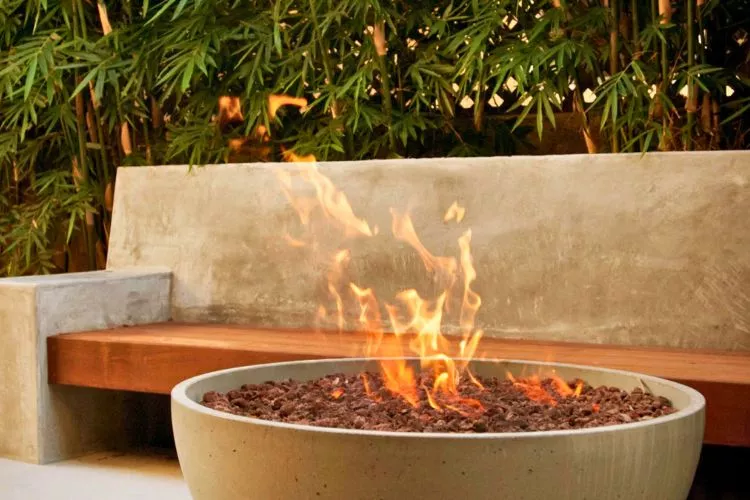
Size and shape
The size and shape of the gazebo you choose are vital factors that significantly influence the final outlook and functionality of your outdoor haven. Depending on the available space and the desired aesthetic, you might opt for circular, square, or rectangular shapes. The dimensions should comfortably accommodate the fire pit while leaving enough room for seating and circulation. Remember, the size should harmonize with the surrounding landscape, and the shape should facilitate easy, safe access to the fire pit, creating a fluid and cohesive environment.
Material selection
Choosing the right materials is not just a matter of aesthetics but also a crucial safety consideration. Opt for non-combustible, fire-resistant materials for the flooring and nearby structures to mitigate the risk of fire hazards. Stone, brick, or concrete are popular choices, offering both safety and a timeless appeal. For the furnishings, considering materials that are flame retardant will add an extra layer of protection and peace of mind, fostering a secure and inviting atmosphere for you and your guests.
Roofing options
The roof of your gazebo plays a critical role in defining the space’s character and safety. A well-designed roof should provide shelter from the elements while allowing for sufficient ventilation, especially when housing a fire pit. You might consider roofs with skylights to enjoy the night sky or adjustable louvers for controlled shade and ventilation. Remember, the roofing material should be fire-resistant, and incorporating features like smoke vents can be a smart move to enhance safety and comfort.
Fire Pit Options That We Have
Embarking on the journey to install a gazebo over a fire pit in your backyard is an exciting endeavor, blending aesthetics with functionality. However, the heart of this setting is undeniably the fire pit itself, a focal point that brings warmth and a welcoming ambiance to your outdoor living space. In this section, we will explore the various fire pit options at your disposal, guiding you to make an informed decision that aligns with your style preferences and safety considerations.
Types of fire pits
Choosing the right fire pit is pivotal in creating a captivating and safe gazebo environment. The market offers various types of fire pits, each boasting unique features and benefits. Let’s delve into the prominent options that can add a warm glow to your outdoor retreat.
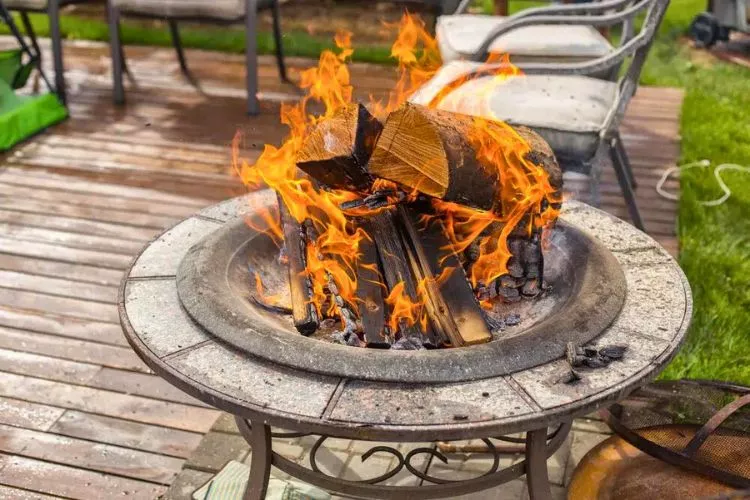
Wood-burning fire pits
Wood-burning fire pits encapsulate a traditional and rustic allure. They provide a crackling soundtrack and the mesmerizing dance of flames that many people associate with a classic fire pit experience. However, they require a steady supply of firewood, and the user must consider the embers and sparks they can produce. Including a spark, screen can be a prudent choice to enjoy the raw beauty of wood fires safely.
Gas fire pits
For those seeking a cleaner, more controlled burn, gas fire pits emerge as a convenient option. Typically fueled by propane or natural gas, these fire pits offer a sleek design and easy operation, igniting at the flick of a switch. Moreover, they don’t produce smoke or flying embers, making for a safer, more comfortable atmosphere. Integrating them into your gazebo setup can bring a modern touch combined with effortless functionality.
Portable vs. built-in fire pits
Weighing the pros and cons between portable and built-in fire pits can influence the versatility and permanence of your setup. Portable fire pits offer flexibility, allowing you to change the layout whenever you wish, and are generally easier and less expensive to install. On the other hand, built-in fire pits are:
- A permanent fixture.
- Often boasting a more cohesive look with the overall landscape design.
- Potentially adding value to your property.
Your choice would depend on your preference for either a steadfast centerpiece or a movable focal point in your gazebo setup.
Placement within the gazebo
Strategizing the placement of the fire pit within the gazebo is a significant step, warranting careful consideration to marry beauty with safety. Here are several factors and examples to keep in mind:

- Center Stage: Placing the fire pit at the center creates a symmetrical aesthetic and naturally directs the flow of traffic around it, fostering a communal ambiance.
- Off-Center Placement: For a more dynamic layout, consider an off-center fire pit. It opens up space for other furniture or features, such as a dining area or a small outdoor kitchenette.
- Raised Platform: Installing the fire pit on a raised platform can help define the space, making the fire pit a clear focal point while potentially offering additional seating on the platform edges.
- In-built Seating: Incorporating seating around the fire pit, whether through built-in benches or complementary furniture, encourages comfort and conversation.
- Integration with Landscaping: Consider how the fire pit integrates with the surrounding landscaping, perhaps near a water feature or nestled amongst lush plants, creating a serene and balanced haven.
Ventilation and smoke management
A well-ventilated gazebo ensures a pleasant and safe environment, particularly when integrating a fire pit into the space. Let’s delve into ways to manage ventilation and smoke effectively:
- Smoke Vents: Installing smoke vents in the roof of the gazebo can facilitate the efficient escape of smoke, particularly for wood-burning fire pits. These can be both functional and aesthetic additions to your design.
- Ceiling Fans: Incorporating ceiling fans can assist in dispersing the smoke and preventing it from settling in one area, fostering a fresher atmosphere.
- Chimney Installation: If your gazebo is enclosed, a chimney installation above the fire pit can be a traditional and effective solution to direct smoke upwards and away from the guests.
- Adequate Roof Height: Ensuring that the roof of the gazebo is at a sufficient height can prevent the accumulation of smoke and heat, making the space more comfortable and safer.
- Open Design Concepts: Opt for open designs, which naturally allow for better ventilation. Incorporating large openings or retractable walls can let the fresh air in while letting the smoke out.
- Quality of Materials: Choosing fire pits that produce less smoke, like gas or propane options, can be a straightforward solution to managing smoke effectively within the gazebo area.
Remember, consulting with a professional can provide guidance tailored to your specific gazebo and fire pit setup, ensuring a seamless and safe integration.
Pros and Cons of Putting a Gazebo Over a Fire Pit
Embarking on the journey of integrating a gazebo with a fire pit? Before diving in, it’s prudent to weigh the potential benefits and drawbacks that come with this decision. This section outlines the varied pros and cons you might encounter, aiding in making an informed and well-rounded choice. Let’s explore.

Pros
Integrating a gazebo over your fire pit isn’t just about aesthetics; it carries several benefits that enhance the comfort and functionality of your outdoor space. Here, we delve into the considerable advantages of this setup:
- Provides Shelter from the Elements: A gazebo offers a welcoming retreat, shielding you and your guests from unexpected rain showers or the harsh afternoon sun. It ensures that your plans aren’t marred by changing weather conditions, allowing for a more enjoyable, year-round outdoor experience.
- Creates a More Intimate and Cozy Atmosphere: Nestling a fire pit within a gazebo instantly ramps up the coziness quotient. The structure fosters a sense of intimacy, making conversations more personal and engaging. It’s like having a little sanctuary where warm memories are forged around the flickering flames.
- Can Help to Reduce Smoke and Wind: Strategically designed gazebos can significantly mitigate the effects of wind, preventing sudden gusts from scattering the fire’s embers or extinguishing the flames. Moreover, with the right ventilation systems in place, it can help channel the smoke away, maintaining a pleasant atmosphere.
- Enhanced Privacy: A gazebo can serve as a private oasis in your backyard, shielding your gathering from prying eyes and creating a secluded space where you can relax and unwind without disturbance.
- Extended Living Space: Installing a gazebo over a fire pit essentially expands your living space, providing an additional area where you can entertain guests, dine, or simply relax with a good book, enjoying the tranquil ambiance and the comforting warmth of the fire pit.
- Increased Property Value: Beyond the immediate benefits, this setup can potentially enhance the value of your property. It’s an appealing feature for potential buyers, representing a ready-made entertainment area that promises comfort and style.
Cons
While the addition of a gazebo over a fire pit undoubtedly introduces a slew of advantages, it’s essential to consider potential drawbacks to ensure your setup is both safe and enjoyable. Here we dissect some of the cons that might arise in this arrangement:
- Can Trap Heat and Smoke, Increasing the Risk of Fire: The closed structure of a gazebo can potentially trap heat and smoke, escalating the risk of a fire outbreak. This scenario accentuates the necessity for incorporating high-quality, fire-resistant materials and an efficient ventilation system to prevent any mishaps.
- Can Make it Difficult to See the Fire: Depending on the design of your gazebo, it might obstruct the clear view of the fire pit. This not only hampers the visual delight that a roaring fire provides but can also make it challenging to gauge the fire’s behavior and safety from all angles.
- Can Restrict Airflow, Increasing the Risk of Carbon Monoxide Poisoning: A poorly designed gazebo can restrict the natural airflow, fostering an environment where harmful gases like carbon monoxide can accumulate. This highlights the critical importance of ensuring your gazebo has ample ventilation to allow fresh air in and prevent the buildup of dangerous gases.
- Complex Installation: Setting up a gazebo over a fire pit isn’t a walk in the park. It demands careful planning and execution, possibly involving consultations with professionals to mitigate safety risks and comply with local regulations.
- Increased Maintenance: With a gazebo comes the added responsibility of regular maintenance. From ensuring structural integrity to seasonal care, the upkeep can be significantly more demanding compared to having a standalone fire pit.
- Potential Legal Restrictions: Depending on your locality, there might be specific regulations and permits required to install a gazebo with a fire pit. Failing to adhere to these could result in legal complications, including fines or being mandated to remove the structure.
- Higher Costs: Incorporating a gazebo over a fire pit can be a substantial investment. Apart from the initial setup costs, you might incur additional expenses in the form of safety installations, maintenance, and possibly higher insurance premiums.
How To Build and Install A Gazebo Over a Fire Pit?
Embarking on the journey to merge the warmth of a fire pit with the elegance of a gazebo? This section serves as your guiding light, outlining the steps and considerations necessary to build and install a gazebo over a fire pit seamlessly. Whether you are a DIY enthusiast or planning to hire a professional contractor, we’ve got you covered with insights and tips to make your project a resounding success.

Step-by-step guide for DIY installation
Embarking on a DIY project to install a gazebo over a fire pit can be an exhilarating adventure. But, to ensure success and safety, it’s pivotal to follow a structured guide. Here, we break down the process into manageable steps, giving you a clear roadmap to your dream backyard setup. Let’s dive right in:
Site preparation
Before you even start thinking about building, the first step is to prepare the site appropriately. This involves choosing a level area, clearing it of debris, and marking out the exact location where the gazebo and fire pit will be situated. Remember to consider underground utilities and to adhere to local regulations regarding clearances and permits.
Gazebo assembly
Once the site is ready, it’s time to assemble your gazebo. Start by laying the foundation, which will provide stability to the structure. Then, follow the manufacturer’s guidelines to erect the gazebo, ensuring that all elements, including posts, beams, and roofing, are securely fastened. During this phase, it’s crucial to maintain a focus on quality and safety, utilizing proper tools and seeking assistance if necessary.
Fire pit installation
After the gazebo is set up, the next step is installing the fire pit. Depending on the type you choose – be it wood-burning, gas, or another type, it needs to be placed in a manner that complies with safety standards. Ensure there’s enough distance from the gazebo’s structure and that adequate ventilation and fire-resistant materials are incorporated into the design to mitigate potential risks.
Hiring a professional contractor
While a DIY project can be immensely satisfying, opting to hire a professional contractor comes with its own set of perks, potentially saving you time and offering expert insights that enhance the longevity and safety of your gazebo and fire pit setup. In this segment, we will explore the numerous benefits that come with professional installation, tips on finding the right contractor, and an overview of the costs involved. Let’s delve deeper into this option:
Benefits of professional installation
When you hire a professional, you’re not just paying for labor; you’re investing in expertise and peace of mind. Professionals come equipped with years of experience, ensuring that your gazebo and fire pit are installed safely and to the highest standards. Moreover, they can foresee and mitigate issues that might not be apparent to the untrained eye, making the installation smoother and more streamlined.
Finding the right contractor
Choosing the right contractor is a pivotal step in ensuring the success of your project. Start by seeking recommendations from friends or online communities, then conduct interviews to gauge their knowledge and experience. Don’t forget to ask for a portfolio of their previous work and client references. Lastly, ensure they are licensed and insured to avoid any potential legal complications.
Costs involved
Installing a gazebo over a fire pit involves several components, and the costs can vary based on the complexity of the project. When working with a contractor, you should anticipate expenses related to labor, materials, and, potentially, permits. It’s advisable to get detailed quotes from a few different contractors to get a sense of the potential budget and to ensure you’re getting the best value for your investment.
You may also find useful: Can You Grill Under A Gazebo? | Best Grill Gazebos 2023
Frequently Asked Questions (FAQs)
Can I put a gazebo over any type of fire pit?
No, not every fire pit is suitable. Consider factors like the type of fire pit, materials, and safety features before installing a gazebo over it.
Do I need a permit to install a gazebo with a fire pit?
Yes, in many regions, obtaining a permit is mandatory for such installations to ensure safety and adherence to local regulations.
Can I convert an existing gazebo into a fire pit enclosure?
Yes, with modifications focusing on safety and ventilation, an existing gazebo can be converted into a fire pit enclosure.
How high should a gazebo be above a fire pit?
The exact height can vary, but generally, it should be high enough to prevent heat damage and allow for proper ventilation, typically at least 10-12 feet (3-3.7 meters).
Conclusion:
In this comprehensive guide, we’ve navigated the critical aspects of installing a gazebo over a fire pit – from safety precautions to design choices. Remember, safety should always be your priority. A well-designed gazebo-fire pit setup not only elevates the aesthetic appeal of your outdoor space but also offers a cozy retreat, melding warmth with style. We hope that this guide has been helpful if you were confused about can you put a gazebo over a fire pit or not.

